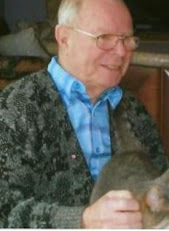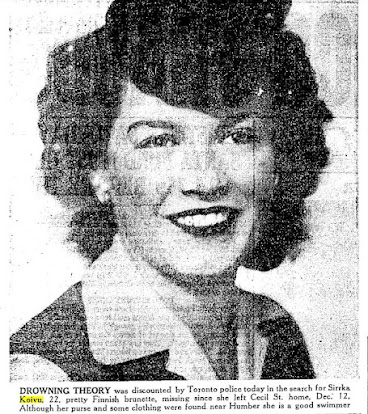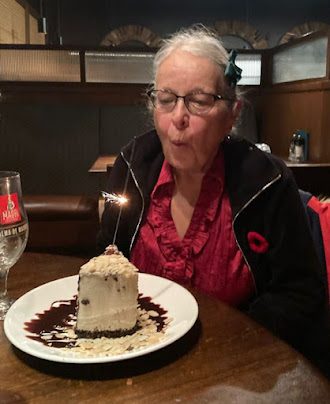#66 A STORY NOT TOLD
We knew Bob, did not know Sirkka
Bob Maas was Dad’s best man; “Uncle Bob’ was a regular drop-in at the cottage for decades and is remembered for his quirky sense of humour and his unique giggle. Bob and Dad, both only children, met at the cottage. Bob was too young to enlist in the Navy in World War II so he joined the Merchant Marine and looked after the ships’ engines. He often made it to the coast of England but never actually set foot on land. Later, Bob worked for his father’s business (Wilson Refrigeration) and he travelled the province looking after cooling and ice-making systems in creameries, arenas and curling rinks. On retirement, Bob moved to Port Elgin to be near his cottage. He joined the Legion and was a loyal fan of the town's many youth sports teams. Bob always had lots of stories to share when he dropped by to visit and he was Dad’s lifetime friend.
BobOn the other hand, Sirkka Koivu was Mom’s bridesmaid and we knew nothing of her. Mom never talked of her.
Sirkka was
born in Finland on July 4, 1926 and immigrated to Canada with her parents as a
young girl. She had a much younger sister; the family ran a boarding house
at 22 Cecil Street Toronto near Kensington Market. Sirkka and my Mom were friends
through the Finnish Young People’s group in Toronto; this was a very active
social club. There are photos of Mom and Sirkka at the Finnish camp on Lake
Wilcox.
Sirkka left
school at age 16 and worked as a seamstress in a dress-making factory. She was Mom’s
bridesmaid in June 1947. A month later (July
26 1947), Sirkka was a passenger in a car where the driver, Ralph Lapalla was
killed instantly. The accident happened at 1 am on Highway 7 between Unionville
and Don Mills. Two cars were passing and apparently there wasn’t enough room
between them, and the front fenders of each vehicle came together. Lapella’s
car swung around and overturned but landed back on its wheels on the road.
Sirkka suffered bruises and shock, but it seems Ralph’s head must have struck
the steering wheel; he broke his neck and died at the scene.
December
1948: Sirkka had purchased Christmas gifts for her family and friends—a pair of
children’s bedroom slippers trimmed with white fur, girls’ rubber boots, toys, a
box of Christmas cards; some gifts were still in their original store wrappings
and hidden in a bureau drawer. On Sunday
December 12th, nothing seemed unusual (except her mother noted that
she didn’t eat, only had a glass of milk.) Sirkka planned to attend an evening concert at
the Finnish Hall; that morning, she chatted with a close friend and promised to
call her back later that day. Early that afternoon, a man called; Sirkka talked
briefly then hung up “in a nervous condition”, put on her coat, said, “I’m
just going out”, and rushed out of the home. She gave the impression that she
would be back soon in case anyone called. Around 7:30 that evening, the family
realized she had not returned. Three days later, relatives became worried and
reported her absence to the police and gave them a description and photos.
Police said
that Sirkka had run away from home before because of disagreements, but each
time returned after her mother put an advertisement in the personal column. But
Mrs. Koivu told police that on this occasion there was no trouble and when she
left the house Sirkka had said she would be back at 5 p.m.
On Friday, a
lifeguard posting signs warning of thin ice at the mouth of the Humber River in
Etobicoke found some clothes on the seawall. (distance from Sirkka’s home to
Humber Bay was 9 ½ km.) There was a single shoe, a single glove, and a short
topcoat with the hood missing and a wallet with $2.35 and Sirkka’s name on some
insurance papers. The river was dragged for three days without success. The
police commented, “We’re satisfied her body is not near the river mouth. If she
is in the water there are only two possibilities. One, she placed the clothes
on the bank and walked a considerable distance away before plunging in. The
other, is that her body, as they not infrequently do, floated out into the
lake.”
So many
questions! How did her clothing manage
to stay on the seawall when the previous day had been windy? (The clothes
should have been swept away by the wind and waves.) The police learned that
Sirkka was noted for her swimming ability and was unusually fond of the water.
(Investigators believed that if she had decided to commit suicide, she would
not have chosen drowning. “None of the men working on this case can recall a
swimmer committing suicide by drowning. They always take some other method.) Another police question. “Why would a person
take off only one shoe and only part of her other clothing? Experience shows
most people plunge in with all their clothing or practically none?”
Police did investigate one Hamilton man, a
previous boarder at the Koivu home, but it turned out he was just a friend of
Sirkka’s. Police found nothing to substantiate foul play but who was the man
who made that mysterious Sunday afternoon telephone call?
On December
24th, police posed a new angle to Sirkka’s disappearance—that she
had avidly read the accounts of the disappearance of another girl and had said to
friends “I’d like to disappear like that sometime.” The police started to believe
that Sirkka had not drowned but had planted the clothing, too obviously, to
create that impression. “Nine persons out of 10, contemplating suicide by
drowning wade into the water fully clothed. Seldom does one,” police said, “remove
a wrist watch and place a coat neatly on a river bank.” Police theorized that the clothing was placed
on the river bank late Thursday night or early Friday morning. Otherwise, they
pointed out the high wind and big waves that lashed the Humber mouth all day Thursday
would have carried the garments out into the lake, The water calmed early on
the Friday morning when the winds subsided. Police interviewed five close
friends who might have known of Sirkka’s whereabouts, but nothing of value was
learned.
When
relatives pointed out that Sirkka’s overcoat was torn and that it appeared that
she had been involved in a struggle, the police interviewed the lifesavers and
concluded that the coat was torn by the men who found it; they had pried it
from the snow and ice and had torn the cloth around the button holes. Reports
that there was blood on the coat were ruled out when an examination showed that
the red stains on the coat were from lipstick.
Police checked
Sirkka’s bank accounts for possible cheques cashed after her disappearance. To
their surprise, there was $4000 in that account. However, Mrs. Koivu explained
that the account was the family’s savings from the boarding house business and in Sirkka’s
name to hide it from the father.
The search for Sirkka went cold for seven months. Every time an unidentified woman’s body was found, friends of the missing dressmaker checked the coroner’s office. Then on the evening of Tuesday, July 5,1949 a body washed ashore on an Etobicoke beach; the body was reported to have a ring with a name inscribed inside. One of Sirkka’s friends was able to translate the “name’ from Finnish; it read “All my love, mother.” Mrs. Koivu made the identification. The body was badly decomposed but there were no skull injuries or other signs of foul play.
Date of
Sirkka’s death is listed as July 6 1949 and cause of death as drowning -asphyxia; the death is noted as a possible suicide. Sirkka is buried in an unmarked
(there is only the cemetery plot marker) grave in Mount Pleasant Cemetery, Toronto. Sirkka’s father, Lauri, aged 50, is
buried nearby, also in an unmarked grave; he died suddenly in January 1949, a month after Sirkka's disappearance. Her mother, Elsa, passed away in
1986.
Sirkka's grave, unmarked except for the cemetery plot marker Mount Pleasant Cemetery, Toronto
What happened to Sirkka is sad and baffling. It is understandable why Mom never mentioned her.











Oh wow great article. What a contrast in fates. Reading it I, too, remember Uncle Bob’s giggle 🤣
ReplyDelete